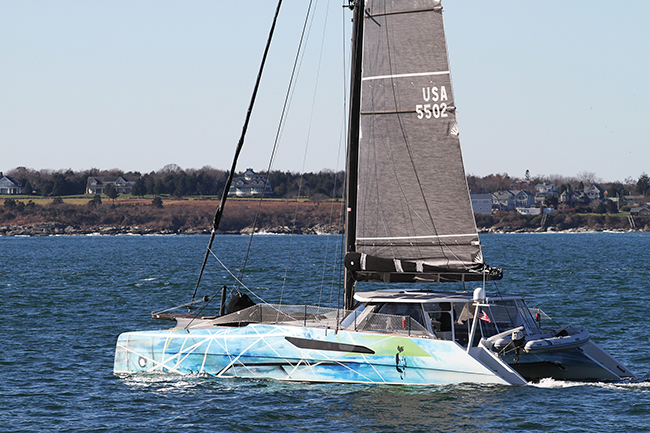A hurried finish to a refit, a new captain and mate, an owner who wanted his catamaran out of New England in late November and in the Bahamas for the holidays: what could possibly go wrong? (published January/February 2018)
Methodical and timely refits are the preferred way of getting things done on boats before they’re relaunched. Given enough time, manpower and advanced notice on tasks that should be completed, boat owners, yards, captains and crews would all prefer that the job list moves forward smoothly and in a timely manner. That’s not always the case, and it’s not always possible. More often than anyone would like, parts are delayed, jobs take longer than anticipated, weather disrupts work flow, rush jobs take priority or other situations arise that delay completion of some refits. It’s reality, and eventually someone has to deal with it. Boats need to be where they need to be, and winter closes in with its inevitable wicked weather.
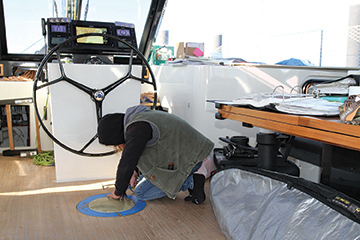 Vandal, a Gunboat 55 catamaran is several years old. She has had problems in the past, including a failed mast step a couple of years ago. One by one, however, those problems are being rooted out by Conrad, a strong, knowledgeable, positive and determined owner. The last time I delivered the boat it was to bring her from North Carolina to Newport with her failed mast step. The Captain at that time, Chris, had other obligations that required his attention, so I agreed to meet him and Vandal in North Carolina to complete the trip to Newport, RI. Chris also was a very capable advocate for Vandal and had been instrumental in helping to iron out a number of initial problems.
Vandal, a Gunboat 55 catamaran is several years old. She has had problems in the past, including a failed mast step a couple of years ago. One by one, however, those problems are being rooted out by Conrad, a strong, knowledgeable, positive and determined owner. The last time I delivered the boat it was to bring her from North Carolina to Newport with her failed mast step. The Captain at that time, Chris, had other obligations that required his attention, so I agreed to meet him and Vandal in North Carolina to complete the trip to Newport, RI. Chris also was a very capable advocate for Vandal and had been instrumental in helping to iron out a number of initial problems.
The original Gunboat company had gone through a chaotic period ending in bankruptcy several years ago. Prior to the bankruptcy a number of Gunboat 55’s were started, a few of which were actually completed prior to the bankruptcy proceedings. It had been an inauspicious start to the product line when Rainmaker was dismasted in a 70 knot February wind gust near the Gulf Steam and abandoned on her maiden voyage out of the North Carolina yard. Vandal was hull number two, but Conrad was intimately involved in the final year of her construction, helping to avoid some of the inevitable initial problems as well as gaining a huge insight into the workings of his new cat.
Gunboats have always been thoroughbreds of speed and elegance, and as such they need a little extra attention. Initially built in South Africa late in the 1990’s and early 2000’s, many of the Gunboat 62’s and 48’s that I helped to deliver to the Caribbean and North America had one problem or another. Each had their own idiosyncrasies, and immediately after I completed the delivery, I would write a comprehensive list of problems or subjective thoughts on how improvements could be made to the boats. Those lists were then sent back to the builders in South Africa. Much to their credit, the problems were never repeated twice. The builders and designers considered those reviews at their “final grade” and took great pride in improving the next boat to come out of the yard.
Fast forward a number of years, and jump to the more recent Gunboat yard in Wanchese, North Carolina where the Gunboat 55 took shape. Shortly after the abandonment of Rainmaker and the launch of Vandal, Gunboat underwent bankruptcy. Several of the 55’s have been completed in nearby yards with a number of modifications, one of which included increasing the length to 57-feet and moving the engine amidships, similar to the earlier 62’s and 48’s. ViVi has been stretched to 57-feet while Thirst maintained the original length and added other modifications. The remaining hulls of the 55’s are quickly being snapped up and customized to owners’ specifications. Meanwhile, buying the Gunboat name and assets out of bankruptcy, the new French-owned Gunboat is coming out with new designs to be built in France.
 That history has led to the situation and realization that virtually all of the Gunboat 55’s are unique custom boats. They each have their own unique identities and idiosyncrasies. Mark, the new Captain and Dara, the new mate onboard Vandal had steep learning curves set in front of them when they arrived from the Caribbean on Friday evening, and they quickly dug into the work of learning the boat. The boats are complex and sailing them is not intuitive to people even with multihull backgrounds. Mechanical, electrical, navigational and communications systems all needed to be learned. Rigging, reefing and halyard locking systems needed to be learned. And, of course the sail inventory needed to be learned – not only how to make the boat move, but also how best to slow it down when conditions exceed expectations.
That history has led to the situation and realization that virtually all of the Gunboat 55’s are unique custom boats. They each have their own unique identities and idiosyncrasies. Mark, the new Captain and Dara, the new mate onboard Vandal had steep learning curves set in front of them when they arrived from the Caribbean on Friday evening, and they quickly dug into the work of learning the boat. The boats are complex and sailing them is not intuitive to people even with multihull backgrounds. Mechanical, electrical, navigational and communications systems all needed to be learned. Rigging, reefing and halyard locking systems needed to be learned. And, of course the sail inventory needed to be learned – not only how to make the boat move, but also how best to slow it down when conditions exceed expectations.
GETTING UNDERWAY
With limited time and at a time of year renowned for quickly deteriorating conditions, provisioning needed to be completed and food stores for weeks in the Bahamas needed to be purchased, organized and stowed. Meanwhile, the boat’s second refit was hastily being completed. I arrived the morning after Mark and Dara. With a favorable weather window for departure beginning in several days, there was obviously plenty to keep us and the boat builders busy for the next few days. Plenty!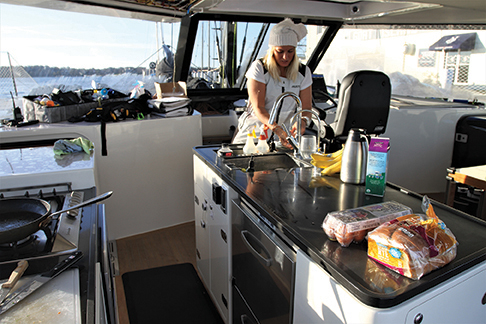
Rigidly adhering to schedules is a known cause of sometimes fatal accidents. Go when you’re ready. Get there when it’s safe. Class reunions, office Christmas parties and anniversaries are not good reasons to risk life, limb and property. However, having said that, problem avoidance during deliveries is often the result of picking the right weather pattern on which to depart. Moderate weather in New England for an extended time in late November is a rare commodity, but as luck would have it, the forecast seemed to favor our departure. But the boat would have to be ready and safe, even if it wasn’t quite perfect in every detail for every backup system. Some of those things could be corrected in Florida later in the winter when a new rig was intended to replace the current mast.
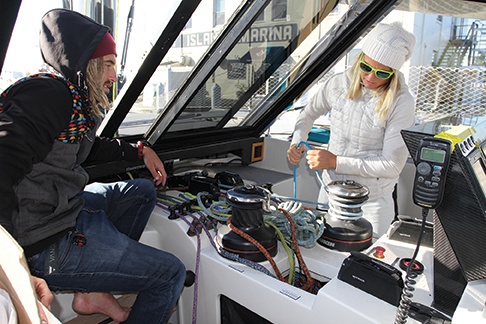 During the day, we broke down into working groups. The contractors had priority to finish their tasks. Dara and Laurie, my partner, went about provisioning and getting the boat cleaned up. Mark and I chased after parts, hardware and spares, and when Conrad arrived, he and Mark went through the boat, checked on contractors and helped with the necessary decision-making regarding the yard’s tasks. Meanwhile, I kept an eye on the upcoming weather, transferred files with emergency procedures and contacts and helped to maintain an urgency to leave on a slowly diminishing favorable weather window. Within a few short days, we were ready to leave, heading towards the Chesapeake Bay to keep all options open but hoping to cross the Gulf Stream east of Cape Hatteras on a southwest wind.
During the day, we broke down into working groups. The contractors had priority to finish their tasks. Dara and Laurie, my partner, went about provisioning and getting the boat cleaned up. Mark and I chased after parts, hardware and spares, and when Conrad arrived, he and Mark went through the boat, checked on contractors and helped with the necessary decision-making regarding the yard’s tasks. Meanwhile, I kept an eye on the upcoming weather, transferred files with emergency procedures and contacts and helped to maintain an urgency to leave on a slowly diminishing favorable weather window. Within a few short days, we were ready to leave, heading towards the Chesapeake Bay to keep all options open but hoping to cross the Gulf Stream east of Cape Hatteras on a southwest wind.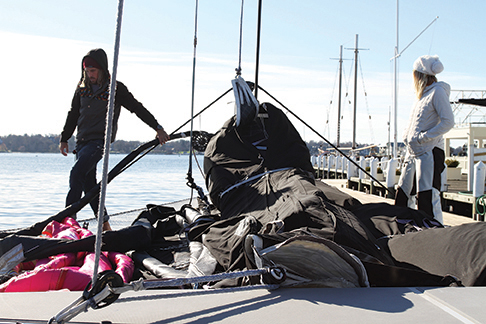
The departure on light northerlies was uneventful, but running low on fuel, the needed stop in Little Creek, outside Norfolk, VA would eat into our time table and the remaining time of favorable weather to cross the Gulf Stream. Getting across the Stream in southerlies or westerlies would be critical with a new Captain, crew and untried equipment. Once the wind built and went to the north, waves would rapidly become steep and breaking. How the new short fixed keels would respond in the waves was still an unknown, and with daggerboards now a thing of the past on Vandal, we wouldn’t have the option of lifting up the leeward board to allow the boat to slide down the wave in heavy weather. We would have to cross the Gulf Stream by heading east, but with the potential of a strong northerly, breaking beam seas might force us onto a premature southerly heading, bucking into the strong Gulf Stream current. The strongest current in the Stream, of course, is along the western wall, and the strength diminishes as you head further east across the Stream.
We managed to cross most of the Stream prior to the wind going to the NW, and as the wind shifted to the right, we were able to head in a more southerly direction towards the Bahamas facing a minimal one knot of current on our starboard bow, rather than directly on our nose. Timing was everything, and we barely made it across the Stream just in time as winds picked up. Happily enough, we were well prepared with a third reef in place. As we bore off to a more southerly heading and cleared the remaining current, the ride smoothed out, and we were across that hurdle.
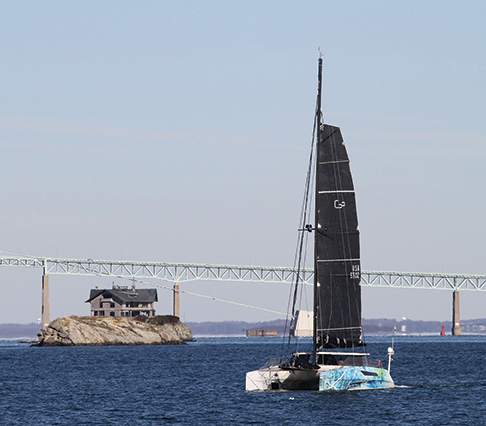 On deliveries, I firmly believe in a conservative sail plan. Light, fast catamarans are easily driven with a minimum of sail area. When only one person is standing watch at a time, a conservative sail plan allows other people enough time to get up and help if conditions require reducing sail area. Avoiding problems is far better than reacting to them or repairing the results of a problem gone wrong. Having plenty of people available and on site to adjust the sails helps to avoid problems. When conditions were light to moderate, we sailed with one reef in the main and the J-1, an 80% reaching jib. Even as we moved south, we had to maintain a constant watch. Light, fast catamarans can get up and sprint if the wind shifts from a beam reach to a close reach or the wind speed gusts an additional 5 knots. Suddenly, you can add 3 to 5 knots to your boat speed. On Gunboats, going from 12 knots to 15 or 16 knots may not be a problem. But if the boat is already doing 16 knots, going to 21 or 22 knots can mean lifting a hull, reducing wetted surface by 50% and suddenly going out of control. So, as a matter of standard operating procedure, on deliveries, we try to maintain a typical speed of around 12 knots. If the person on watch is regularly exceeding that parameter, it’s probably time to slow the boat down so surprises don’t ruin the day.
On deliveries, I firmly believe in a conservative sail plan. Light, fast catamarans are easily driven with a minimum of sail area. When only one person is standing watch at a time, a conservative sail plan allows other people enough time to get up and help if conditions require reducing sail area. Avoiding problems is far better than reacting to them or repairing the results of a problem gone wrong. Having plenty of people available and on site to adjust the sails helps to avoid problems. When conditions were light to moderate, we sailed with one reef in the main and the J-1, an 80% reaching jib. Even as we moved south, we had to maintain a constant watch. Light, fast catamarans can get up and sprint if the wind shifts from a beam reach to a close reach or the wind speed gusts an additional 5 knots. Suddenly, you can add 3 to 5 knots to your boat speed. On Gunboats, going from 12 knots to 15 or 16 knots may not be a problem. But if the boat is already doing 16 knots, going to 21 or 22 knots can mean lifting a hull, reducing wetted surface by 50% and suddenly going out of control. So, as a matter of standard operating procedure, on deliveries, we try to maintain a typical speed of around 12 knots. If the person on watch is regularly exceeding that parameter, it’s probably time to slow the boat down so surprises don’t ruin the day.
At one point, while approaching a cloud line, we decided to change down from the J-1 to the solent with that sail’s foot reefed down to further reduce its size. When clouds stretch from horizon to horizon, I think of them like streams of flotsam along a tide line. In the water, when a current is going in one direction and an adjacent current is going in another direction, streams of flotsam create a line in the water. Clouds seem to line up in a similar way when wind currents flow in one direction on one side of the line of clouds and flow in another direction on the other side of the cloud line. It also seems that when that cloud line is very low and closer to the surface of the water, the wind strength seems to be stronger near and under the cloud line. The lower the cloud line, the stronger the wind speed. It may not always hold true, but it has often enough to help me avoid scrambling to reduce sail area under a line of clouds.
Later, with skies continuing to darken from cloud cover and night approaching, we decided to completely drop the main, run the main halyard to the outboard end of the boom, sheet on the boom to support the back of the mast, sail with the reefed solent, and run both engines. If squalls became violent, we would easily be able to manage the boat without changing the sail plan in the dark. If conditions became lighter, we could still maintain a reasonable time of day to make our landfall in the Bahamas.
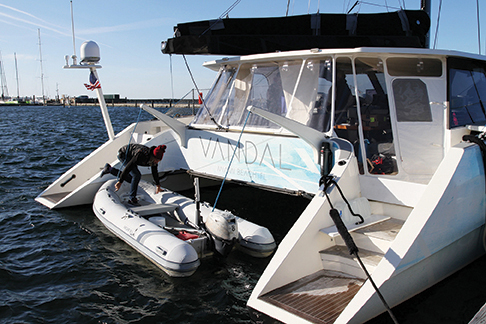 Every boat and delivery is different, whether they are aboard a multihull or a monohull. What makes them all possible and even enjoyable are the people involved. Even when singlehanding, a number of people have helped make it all possible. In Vandal’s case, the contractors and crew all made it possible. And given Mark’s and Conrad’s focus and efforts, the trip was a genuine joy to see how it was possible to pull so many tasks together in such short order to make it all happen – safely.
Every boat and delivery is different, whether they are aboard a multihull or a monohull. What makes them all possible and even enjoyable are the people involved. Even when singlehanding, a number of people have helped make it all possible. In Vandal’s case, the contractors and crew all made it possible. And given Mark’s and Conrad’s focus and efforts, the trip was a genuine joy to see how it was possible to pull so many tasks together in such short order to make it all happen – safely.

















